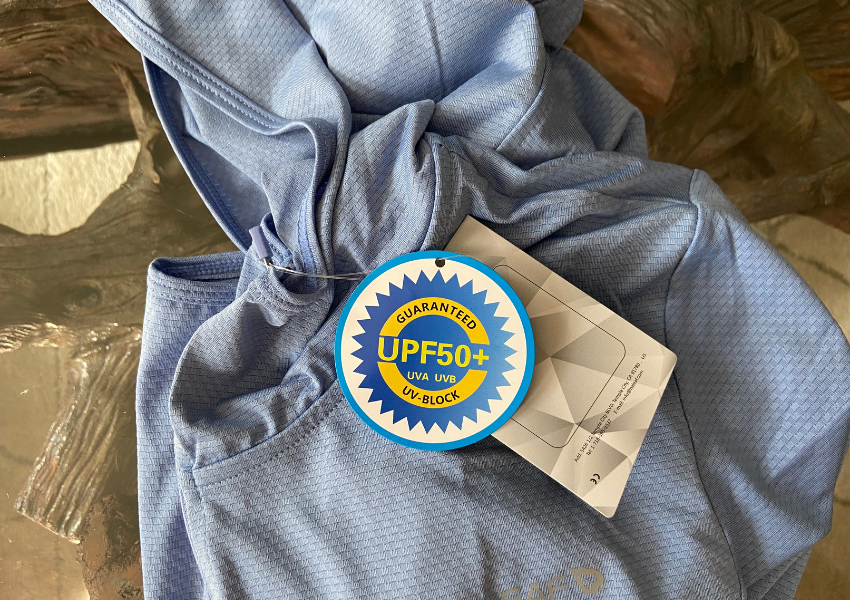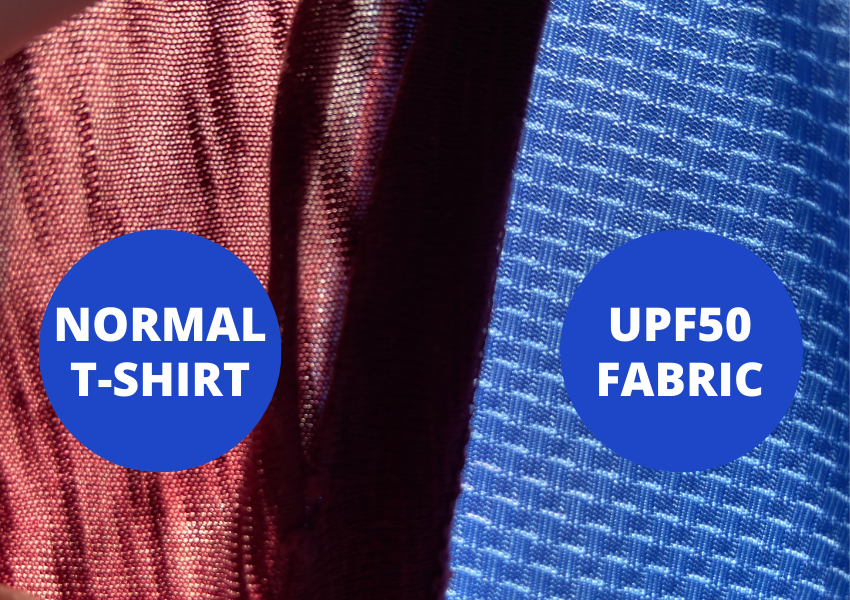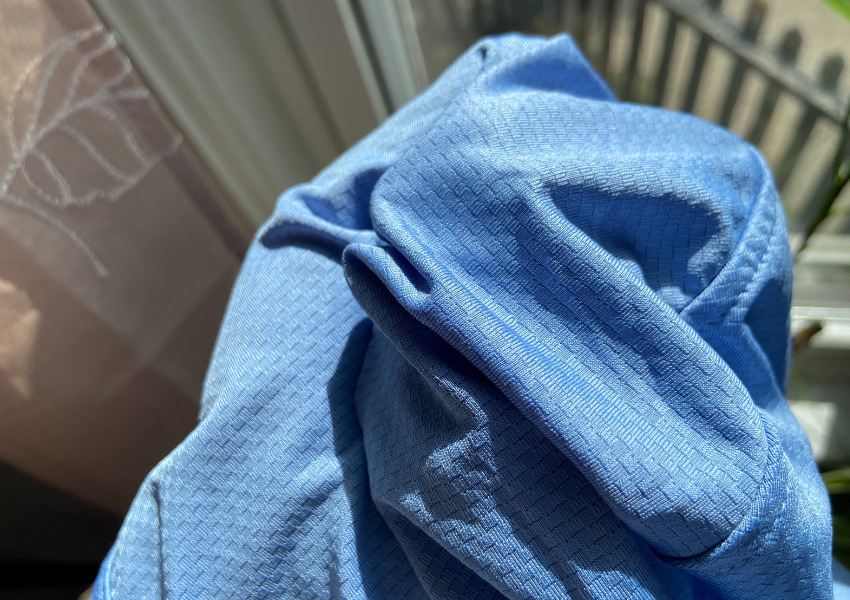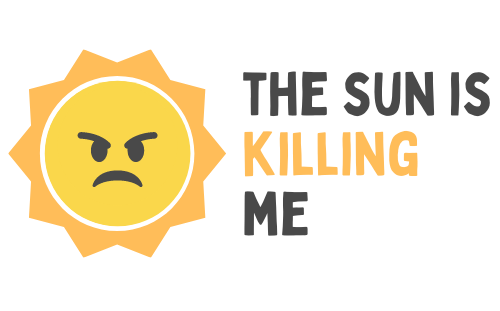Feeling confused about what exactly are UPF clothes? Don’t worry, we’ll break down everything you need to know about UPF clothing here by answering your hottest questions!
What is a UPF rating? What does it mean?
UPF stands for Ultraviolet Protection Factor. A piece of clothing’s UPF rating identifies how much of the sun’s UV rays can penetrate through the fabric.
For example, if you have a UV protective shirt that has a UPF50 rating, that means that only 1/50th of the sun’s UV radiation can get through the material and reach your skin. In other words, the fabric will block 98% of the UV rays and reduce your skin’s UV radiation exposure by 50 times.

Most everyday clothing allows some amount of visible light to pass through, indicating a relatively low UPF rating. If you hold up traditional clothing up to a lamp or up to the sun, you’ll likely see light filtering through the fabric, indicating a relatively low UPF rating.
High UPF-rated clothing has a tighter weave of materials, allowing less (or nearly no) visible light to pass through, providing great UV protection.
Traditional, everyday summer clothing tends to have a low UPF rating that’s usually under 10, which is why specialized UPF clothing is essential for warmer weather!
What’s the difference between UPF and SPF?
Both UPF and SPF are ratings that are connected to sun protection, but there are major differences in what these rating systems are used to measure.
While a UPF rating is used to measure an article of clothing’s ability to block UV rays, SPF is a rating system specifically used for sunscreens.
Basically, UPF rates textiles, with SPF rates topical applications applied directly to the skin.
SPF stands for Sun Protection Factor. It measures how well a sunscreen can block UVB rays. It’s important to note that SPF does not measure UVA protection, and is generally accepted as an imperfect rating method for measuring a sunscreen’s ability to protect your skin from the sun.
This is why, in addition to looking at a sunscreen’s SPF number, you’ll also want to look for the “broad spectrum” label, which indicates that the sunscreen protects your skin from both UVA and UVB rays.
UPF on the other hand, measures a fabric’s ability to block both UVA as well as UVB rays.
Does UPF clothing lose its effectiveness after being washed?
This really depends on how the clothing has been treated and how it is designed to block UV.
For example, some manufacturers treat their UPF fabrics with titanium dioxide or zinc oxide. Often used as an ingredient in physical mineral sunscreens, zinc oxide and titanium dioxide are coated onto the fabric to help bolster the clothing’s UV-blocking abilities.
The problem with clothes that obtain their UPF rating via chemical treatments is that those properties will lessen over time as the clothing is washed. The good news is that it usually takes many washing before a piece of clothing will begin to lose some of those UV-blocking properties. And even as the treatments wash off, the clothing will still retain some sun-blocking ability.
Other companies rely entirely on using fabric materials that are well-suited to blocking UV rays such as nylon or polyester. In these cases, washing does not necessarily affect UPF effectiveness.
However, all clothes will loosen and degenerate over time, which will affect the clothing’s ability to provide protection.
There are a number of different factors that may cause UPF clothing to lose its effectiveness after washing. The way in which the clothing is treated and designed, as well as how it is cared for by you, all play into this loss of effectiveness.
What makes an article of clothing protective against UV rays?
There are a number of ways a piece of clothing can achieve a high UPF rating and provide good UV protection.
Fabric construction and type is very important. Some fabric materials are better at blocking UV rays than others, with polyester, nylon, and other synthetic materials providing the most protection.
The clothing’s weave is also important. Clothing with a loose weave and thin fibers will let in much more light than clothing with thicker fibers and a dense weave.

Materials like denim and wool are excellent for UV protection because they have a tight weave and a heavyweight. If you’ve ever held up a pair of jeans or a wool coat against a light, you’ll probably notice that no light shines through!
Of course, most individuals don’t want to wear heavy denim and wool in the summer, which is why more modern synthetic fibers are best. Modern UV clothing manages to be lightweight and comfortable while still blocking UV rays.
Color is another factor that affects a piece of clothing’s UPF rating. Certain colors are better for sun protection than others. Darker-colored clothing uses more dye, which allows the clothing to absorb more UV radiation, resulting in a generally higher UPF rating.
While darker colors absorb UV radiation, light colors reflect light and energy, bouncing some of the sun’s light back towards your body and resulting in less protection.
It should be noted that it isn’t just dark colors that absorb UV radiation better – the same is true for any bright, vivid colors. This is because bright colors like reds and neon greens require a lot of dye to achieve their colors.
Despite darker and more vivid colors providing more protection, many individuals still choose to opt for light colors and whites because they’re generally cooler to wear. The absorption of the sun’s heat provided by darker clothing protects your skin, but can make you feel warmer.
The good news is that color has much less to do with a clothing’s UPF rating than the fabric material and weave. Modern sun protective clothing can provide great protection no matter what color shirt you choose!
What are common features of UV clothing?
Most articles of UV clothing have the following features:
- Long sleeves. Most UV shirts feature long sleeves (and sometimes even thumb holes to provide some wrist and hand coverage too). The goal of most UV clothing is to protect as much of your skin as is functionally possible while still keeping you comfortable!
- High neck lines. Many shirts feature high neck lines that cover as much of your upper chest as possible, and sometimes even some of your lower neck.
- Moisture-wicking properties. Many modern UV-blocking fabrics feature moisture-wicking abilities, which allows the clothing to absorb your sweat and move it towards the exterior of the clothing, where it can be more easily evaporated by the sun. This also means that UV clothing is often quick drying – a handy feature for swim shirts! Plus, the evaporation of sweat and moisture from the exterior layer of the clothing provided a cooling effect, keeping you more comfortable.
- Ventilation panels. Some UV shirts are designed to let in some air, and feature ventilation panels (usually under the armpits) that allow wind to flow through the shirt while still providing full coverage of your skin.
- Lightweight fabrics. UV clothing is generally lightweight, making the apparel comfortable to wear even in the heat of the summer.
- Loose fit. Most UV clothing should be loose fitting. The Skin Cancer Foundation specifically advocates for loose-fitting sun-protective clothing because tight clothing can stretch. The stretching action can reduce your protection, as when the fibers pull away from each other, more UV rays are allowed to pass through.
- Dark colors. Darker and more vivid colors tend to absorb more UV radiation than lighter clothing.
- Knee-length dresses and skirts. Longer dressed and skirts provide more coverage for your skin than shorter options.
Is sun protective clothing better than sunscreen?
This largely depends on how you define “better.”
On one hand, sun protective clothing is less of a hassle to put on your body when compared to sunscreen. UPF clothing also doesn’t require you to reapply frequently, as sunscreen does. It also retains all its UV-blocking abilities even after being worn in the water!
On the other hand, some people prefer to feel the sun against their skin at the beach. Most UV clothing is extremely lightweight, so feeling hotter shouldn’t be an issue. But some people just can’t resist the feeling of their skin against a sea breeze!
Ultimately, the best option is to combine UV clothing with sunscreen. We’d suggest using UV clothing to cover as much of your body as possible and use sunscreen to cover any areas of skin the clothing doesn’t cover, such as your face, hands, feet, etc.
What are the best types of UPF clothing?
When it comes to sun protective clothing, there are actually many more choices than you might realize! Popular forms of UPF clothing include:
- Sun shirts
- Swim shirts
- Wide-brimmed sun hats
- Sun gloves
- Sun shawls and wraps
- Sun arm sleeves
- Sun shorts and pants
Do I need to wear sunscreen underneath UV clothing?
No, you do not need to apply sunscreen underneath your UV clothing. Sun protective clothing works very well, and the clothing will provide the protection you need from the sun! However, you will want to wear sunscreen on any exposed areas. These usually includes your face, hands, and feet.
Is sun protective clothing more appropriate for certain times of year?
Your body needs to be protected from the sun no matter what time of year it is. However, UV clothing is usually most popular during warmer summer months. This is because in the winter, most people wear enough layers of clothes and thick enough clothing that they will already be protected from UV rays!

In the summer, when people are less inclined to layer up and want lightweight clothing, UV clothing is perfect for providing necessary protection while still keeping the wearer cool and comfortable.
It should be noted that even in the winter, you will want to be applying sunscreen to your face and hands – basically, anywhere your clothing isn’t covering you.
What does UPF clothing feel like to wear?
UV clothing doesn’t feel much different from regular clothing – after all, the goal of UPF clothing is to be as functional and comfortable as possible! However, UPF clothing generally tends to feel similar to wearing exercise workout clothing that’s loose and lightweight.

Does UPF clothing keep you cool?
Yes, UPF clothing can help keep the wearer feel cool through moisture-wicking fibers. Moisture-wicking materials can draw your sweat away from your skin and move it towards the surface of the clothing, where it can be evaporated easily by the sun. This results in an evaporative cooling process that leaves your skin feeling cooler than it would otherwise.
If you’re curious to understand more about how evaporative cooling works, the Ministry of Supply has a detailed explanation.
Where can I buy UV protective UPF clothing?
It used to be that UV protective clothing was only available at specialty outdoor clothing stores, but as concern over UV protection increases, more and more major retailers are now carrying UV-protective goods.
In fact, it’s not unusual to find UPF clothing at a variety of big box retailers including Walmart, Target, Macy’s, Kohls, TJ Maxx, and Costco. And of course, there is plenty of UPF clothing available on Amazon (although it’s worth noting that sun protective clothing can be fairly expensive).
However, in order to find the widest selection of UPF clothing with the greatest variation in styles and designs, make sure to check out our guide to the best UPF clothing brands.
Does UV light go through clothes?
Yes, UV light can easily pass through most standard clothing.
UV radiation is designed to penetrate most substances, and as a result, only materials that are specifically designed to be UV protective can shield you from UV rays.
You can easily see how much light can pass through an article of clothing by holding up the clothing to the sun or to a light. If you can see light through the clothing, UV rays can penetrate your skin!
One study has shown that a plain white cotton shirt offers just a (roughly) UPF10 rating.
For everyday use, most clothing without a UPF label can provide adequate sun protection. For example, a standard cotton shirt can have a UPF rating of (roughly) just 5.
How can I increase the UPF of clothing?
The easiest option is to simply purchase clothing that is rated UPF50 and above, as you can guarantee that those articles of clothing have adequate UV protection.
However, there are some other ways you can boost your clothing’s UV protection abilities. There are laundry treatments you can apply to your clothing that will add a layer of UV protection.
One such popular option is the Rit Sun Guard Laundry Treatment, which promises as high as 30 UPF protection. All you have to do is add the sun guard treatment to your normal load of laundry in the washing machine, and the clothing will gain a UPF30 protectorate that lasts for up to 20 future washes.
Who regulates UPF clothing ratings?
In the United States, UPF clothing is regulated by the Federal Trade Commission (FTC). Sunscreen, on the other hand, is regulated by the Food and Drug Administration (FDA).
No article of clothing can be labeled “sun protective” if it has a UPF that is less than 15. The Skin Cancer Foundation specifically recommends clothing with a UPF of 30 or higher.
The major international standard for UPF clothing is from ASTM International, which uses a common rating scale. For their evaluation, 15-24 os “good,” 25-39 os “very good” and 40 and higher equates to “excellent”.
The good news is, some studies have shown that UPF ratings for clothing are actually underestimated since the clothing is tested under direct sunlight. In reality, people wear the clothing in situations where the sun will be coming from a variety of angles depending on the time of day and situation, and often not under direct sunlight.
How should I wash UPF clothing?
The best way to care for your UPF clothing is to use cold water and mild detergent, but no bleach or softeners.
Some UPF clothing required hand washing – always follow the manufacturer’s instructions. If the clothing can be washed via a washing machine, use a delicate or hand-wash cycle.
Hang the clothing out in the shade on a line or flat surface to dry. Do not put clothes in the dryer if they are labeled as sun-protective, as heat can reduce their effectiveness.
How long does UPF clothing last?
UPF clothing won’t retain its maximum efficacy forever. Most companies test their clothing and promise the labeled UPF rating for up to 30-40 washes. So consider purchasing new UPF clothing every couple of years.
What is the minimum UPF rating I should look for?
It’s recommended you should always opt for clothing with a UPF rating of 30 or above. A fabric must have a UPF30 or higher rating in order to qualify for The Skin Cancer Foundation’s Seal of Recommendation.
However, you should try to purchase UV clothing with a UPF rating of 50 ideally, as that is the highest level of protection you can get.


Hi,
thanks for an informative article. Is it true that a fabric thread with count of 180, generally gives a UPF 50 protection?
Kind regards, Matt